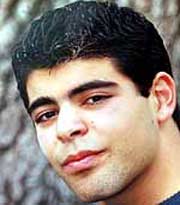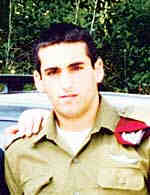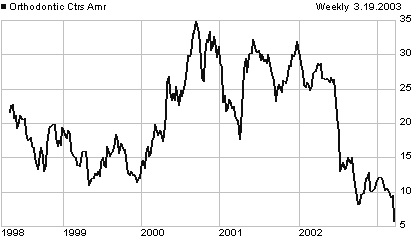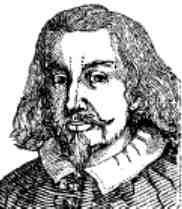 Deaths
which occurred on a March 19: Deaths
which occurred on a March 19:
2004 George
Elias Khouri, 20 [photo >], in the evening as
he jogged in Jerusalem's French Hill district, near Hebrew University, was
shot in drive-by militants of al-Aqsa Martyrs Brigades, and dies soon afterwards.
George Khouri, an economics student at Hebrew University, was the son of
prominent Israeli-Arab lawyer Elias Khouri, a well known activist for the
Palestinian cause, who has often represented Palestinian militants jailed
by Israel, and whose father was among 14 people killed in a Palestinian
bomb attack Zion Square in central Jerusalem in 1975. The next day the al-Aqsa
Martyrs Brigades announce: “"The fighters thought that he was a settler
jogging in an area full of settlers. It was a mistake and we extend our
apology to his family" and "We will consider him as a martyr like hundreds
of Palestinians killed by Israeli occupation forces."
 2004
Ali al-Khatib, from wounds sustained the previous day when he was
shot from behind by US troops manning a checkpoint in central Baghdad, Iraq,
as the car in which he was drove away. He was a correspondent for Dubai-based
satellite television channel Al Arabiya, whose cameraman Ali Abdelaziz,
in the same car, was killed immediately. 2004
Ali al-Khatib, from wounds sustained the previous day when he was
shot from behind by US troops manning a checkpoint in central Baghdad, Iraq,
as the car in which he was drove away. He was a correspondent for Dubai-based
satellite television channel Al Arabiya, whose cameraman Ali Abdelaziz,
in the same car, was killed immediately.
2003 Zion Boshirian,
50, Israeli, shot in the head, in the afternoon, by gunmen of the al-Aqsa
Martyrs Brigade, near Jenin, between the West Bank enclave settlements and
Shaked and Movo Dotan, to which he was driving home alone, from his place
of work as a tax adviser in Hadera.
2002 Tal Tzemach,
20 [< photo], Israeli lieutenant, and Ahmad Atik
and Salah Kamil, of the military arm of Hamas, from nearby Jenin,
who, in the early morning, fire their Kalashnikov rifles from a distance
of about 30 meters at Tzemach (who is from Kibbutz Hulda) and 14 other Israeli
soldiers from an elite (?!) unit camped out for the third night in the same
spot of Hamam al-Malih area in the northern Jordan Valley, without adequate
sentries. Within 10 minutes, Israeli reinforcements start arriving, then
kill the assailants. The Israeli brigade headquarters had received specific
warnings about the infiltration of two terrorists in this area several hours
before the attack, but this information did not reach the soldiers in the
field.
2002 Amjad al-Alami, 22, Palestinian journalist,
shot by Israeli troops while standing outside his photography shop in Beit
Omar, north of Hebron, West Bank.
 2002
Marco Biagi, 51 [photo >], shot by two gunmen
on a motorcycle as he arrived at his Bologna home on his bicycle at about
20:30. An economist and law professor at the University of Modena, he was
an advisor to the Italian center-right government's labor minister, Roberto
Maroni, of the anti-immigrant Northern League. The previous week, the cabinet
had approved Biagi's proposals to amend the current labor law, to make it
easier to fire workers. His last editorial, headlined "Chi
frena le riforme è contro l'Europa," was published the very same day
in Milan's Il
Sole 24 Ore. Previously, other Italian government economy advisers
have been the victims of attacks. To mention only two that were fatal: Ezio
Tarantelli, professore di Economia del lavoro alla Sapienza e sindacalista
della Cisl, fu ucciso nella notte tra il 26 e il 27 marzo 1985 in un attentato
rivendicato dalle Brigate
Rosse. Il 20 May 1999 Massimo D'Antona, 51 anni, fu
freddato da due killer con tre colpi di pistola al torace. D'Antona, docente
di diritto del lavoro all'Università La Sapienza, era stato sottosegretario
ai Trasporti nel Governo Dini e aveva collaborato con il ministro del Lavoro
Treu. Bassolino gli aveva affidato l'incarico di coordinare sia la commissione
di esperti per la riforma degli ammortizzatori sociali sia il comitato consultivo
per la riforma della legislazione del lavoro. L'omicidio D'Antona fu rivendicato
dalle Brigate Rosse–Partito Comunista Combattente, e D'Antona era indicato
come uno dei protagonisti della politica economica del Governo. 2002
Marco Biagi, 51 [photo >], shot by two gunmen
on a motorcycle as he arrived at his Bologna home on his bicycle at about
20:30. An economist and law professor at the University of Modena, he was
an advisor to the Italian center-right government's labor minister, Roberto
Maroni, of the anti-immigrant Northern League. The previous week, the cabinet
had approved Biagi's proposals to amend the current labor law, to make it
easier to fire workers. His last editorial, headlined "Chi
frena le riforme è contro l'Europa," was published the very same day
in Milan's Il
Sole 24 Ore. Previously, other Italian government economy advisers
have been the victims of attacks. To mention only two that were fatal: Ezio
Tarantelli, professore di Economia del lavoro alla Sapienza e sindacalista
della Cisl, fu ucciso nella notte tra il 26 e il 27 marzo 1985 in un attentato
rivendicato dalle Brigate
Rosse. Il 20 May 1999 Massimo D'Antona, 51 anni, fu
freddato da due killer con tre colpi di pistola al torace. D'Antona, docente
di diritto del lavoro all'Università La Sapienza, era stato sottosegretario
ai Trasporti nel Governo Dini e aveva collaborato con il ministro del Lavoro
Treu. Bassolino gli aveva affidato l'incarico di coordinare sia la commissione
di esperti per la riforma degli ammortizzatori sociali sia il comitato consultivo
per la riforma della legislazione del lavoro. L'omicidio D'Antona fu rivendicato
dalle Brigate Rosse–Partito Comunista Combattente, e D'Antona era indicato
come uno dei protagonisti della politica economica del Governo.
2002
Khattab, Saudi Chechen Resistance leader, by the Russian secret
service by means of a poisoned letter.
2002 Suzanne Bartlett,
39, beaten with an iron pestle and strangled with a computer cord by her
husband Lt. Col. David Bartlett Jr., 46, branch chief of the operations
research group at the Center for Strategic Leadership at the US Army War
College, as the was harassing him, calling him insulting names, and shoving
him, after several days of quarelling about his viewing pornography on the
Internet. At his court martial on 30 September 2002 he would, in a plea
agreement, plead guilty to unpremeditated murder and be sentenced in October
2002 to prison for life without the possibility of parole..
2001
Baruch Cohen, 58, Israeli resident of the West Bank enclave settlement
of Efrat, near Bethlehem, shot as he was driving. Since the beginning of
the al-Aqsa intifada, 430 people have been killed, including 352 Palestinians,
59 Israeli Jews, and 19 others.
2001 Charles K. Johnson,
76, a retired aircraft mechanic for Pan Am, president of the Flat
Earth Society (the Earth is a disk with the North Pole at the center
and ice along the circumference, no Antarctica) [July
1980 article on his beliefs].[critical
quoting of some Flat Earth vituperations]
1999 Al menos
60 personas por una bomba que explota en el mercado central de
Vladikavkaz, capital de la república rusa de Osetia del Norte. Causa heridas
a más de 100 personas.
1999 José Agustín Goytisolo,
poeta español.
1997 Willem de Kooning, 92, in East
Hampton, NY, Dutch US Abstract
Expressionist painter born on 24 April 1904. — — MORE
ON DE KOONING AT ART “4” MARCH
with links to images.
1994 José Coronel Urtecho,
poeta nicaragüense.
1988 Two British soldiers, shot
after they were dragged from a car and beaten by mourners attending an Irish
Republican Army funeral in Belfast, Northern Ireland.
1987
Louis
de Broglie, 94, French mathematician, physicist (Nobel 1929)
— Premio Nobel de Física 1929 por sus investigaciones acerca del comportamiento
ondulatorio del electrón.
1984 Un supuesto agente
de los GAL (Grupos Antiterroristas de Liberación) es destrozado en
Biarritz al estallar un coche-bomba.
1978 Gaston
Julia, mathematician.
1945 Some 800 killed in
Kamikaze attack of USS Franklin off Japan The ship is
saved.
1945
Friedrich Fromm, general executed for plot against Hitler.
^top^
The commander of the German Home Army, Gen. Friedrich Fromm, is shot
by a firing squad for his part in the July plot to assassinate the
Fuhrer. The fact that Fromm's participation was half-hearted did not
save him. By 1945, many high-ranking German officials had made up
their minds that Hitler must die. He was leading Germany in a suicidal
war on two fronts, and they believed that assassination was the only
way to stop him. According to the plan, coup d'etat would follow the
assassination, and a new government in Berlin would save Germany from
complete destruction at the hands of the Allies. All did not go according
to plan, however. Col. Claus von Stauffenberg was given the task of
planting a bomb during a conference that was to be held at Hitler's
holiday retreat, Berchtesgaden (but was later moved to Hitler's headquarters
at Rastenburg). Stauffenberg was chief of staff to Gen. Friedrich
Fromm. Fromm, chief of the Home Army (composed of reservists who remained
behind the front lines to preserve order at home), was inclined to
the conspirators' plot, but agreed to cooperate actively in the coup
only if the assassination was successful.
On the night of 20 July, Stauffenberg planted an explosive-filled
briefcase under a table in the conference room at Rastenburg. Hitler
was studying a map of the Eastern Front as Colonel Heinz Brandt, trying
to get a better look at the map, moved the briefcase out of place,
farther away from where the Fuhrer was standing. At 12:42 the bomb
went off. When the smoke cleared, Hitler was wounded, charred, and
even suffered the temporary paralysis of one arm-but was very much
alive. Meanwhile, Stauffenberg had made his way to Berlin to meet
with his co-conspirators to carry out Operation Valkyrie, the overthrow
of the central government. Once in the capital, General Fromm, who
had been informed by phone that Hitler was wounded but still alive,
ordered Stauffenberg and his men arrested, but Fromm was located and
locked in an office by Nazi police. Stauffenberg and Gen. Friedrich
Olbricht began issuing orders for the commandeering of various government
buildings.
Then the news came
through from Herman Goering that Hitler was alive. Fromm, released
from confinement by officers still loyal to Hitler, and anxious to
have his own association with the conspirators covered up quickly,
ordered the conspirators, including two Stauffenberg aides, shot for
high treason that same day. (Gen. Ludwig Beck, one of the conspiracy
leaders and an older man, was allowed the "dignity" of committing
suicide.) Fromm's last-ditch effort to distance himself from the plot
failed. Within the next few days, on order of Heinrich Himmler, who
was now the new head of the Home Army, Fromm was arrested. In February
1945, he was tried before the People's Court and denigrated for his
cowardice in refusing to stand up to the plotters. But because he
went so far as to execute Stauffenberg and his partners on the night
of 20 July, he was spared the worst punishment afforded convicted
conspirators-strangulation on a meat hook. He is shot by a firing
squad on 19 March. |
1942 José Díaz Ramos, secretario general del PCE.
1930 Arthur James Balfour, 81, British Foreign Secretary.
1922 Mathews,
mathematician.
1918 Edward William Stott, British
artist born in 1859. [All weigh Stott from what he always taught.] —
LINKS
1896 George Richmond, English painter born on 28
March 1809. — more
with links to images.
1862 Wilhelm Friedrich Schadow,
German artist born on 06 September 1862. — more
with link to an image.
1687 Robert Cavelier [LaSalle]
French explorer murdered in what is now TX
1685 Sluze,
mathematician.
1677 Anthonie van Borssom (or Borssum),
Dutch artist born in 1631. — [Does his artwork bore some people? Is
that why I cannot find any example of it on the internet?] |
 On
a March 19:
On
a March 19: 1985
IBM discontinues its junk, chiclet-keyboard PC Jr., of which it had sold
only 240'000 during its 16 months on the market. [photo >]
1985
IBM discontinues its junk, chiclet-keyboard PC Jr., of which it had sold
only 240'000 during its 16 months on the market. [photo >] Deaths
Deaths 2004
Ali al-Khatib, from wounds sustained the previous day when he was
shot from behind by US troops manning a checkpoint in central Baghdad, Iraq,
as the car in which he was drove away. He was a correspondent for Dubai-based
satellite television channel Al Arabiya, whose cameraman Ali Abdelaziz,
in the same car, was killed immediately.
2004
Ali al-Khatib, from wounds sustained the previous day when he was
shot from behind by US troops manning a checkpoint in central Baghdad, Iraq,
as the car in which he was drove away. He was a correspondent for Dubai-based
satellite television channel Al Arabiya, whose cameraman Ali Abdelaziz,
in the same car, was killed immediately. 2002
Marco Biagi, 51 [photo >], shot by two gunmen
on a motorcycle as he arrived at his Bologna home on his bicycle at about
20:30. An economist and law professor at the University of Modena, he was
an advisor to the Italian center-right government's labor minister, Roberto
Maroni, of the anti-immigrant Northern League. The previous week, the cabinet
had approved Biagi's proposals to amend the current labor law, to make it
easier to fire workers. His last editorial, headlined "
2002
Marco Biagi, 51 [photo >], shot by two gunmen
on a motorcycle as he arrived at his Bologna home on his bicycle at about
20:30. An economist and law professor at the University of Modena, he was
an advisor to the Italian center-right government's labor minister, Roberto
Maroni, of the anti-immigrant Northern League. The previous week, the cabinet
had approved Biagi's proposals to amend the current labor law, to make it
easier to fire workers. His last editorial, headlined "

 1488
1488